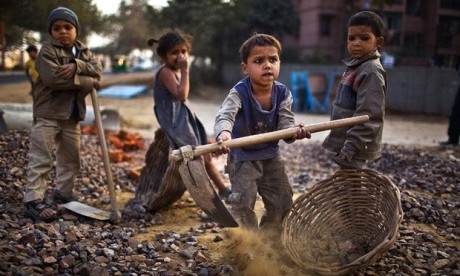On the day that Durga Mala was rescued, she lay crying on the stone floor, where she was attempting to cool her back. She was 11 years old and her skin was covered with blisters, from her shoulder blades to her buttocks. A few days earlier, her owners had poured hot oil over her because they thought she was working too slowly.
Suddenly Durga heard screams and huddled on the floor. Acting on a tip, police stormed the apartment in the heart of Bangalore. When they broke the door down, Durga crossed her arms in front of her chest and closed her eyes. She was only wearing a pair of panties — that’s all the clothing that her owners had allowed her to have. Durga says: “I was ashamed.”
One of the men wrapped the small girl in a sheet and brought her to a hospital. Doctors treated her for a number of days. In addition to her burns, she was malnourished, infected wounds covered her fingers and her lips were scarred. “I dropped a glass once,” says Durga, “and the woman got angry and pulled my fingernails out, one by one.” Sometimes they poked her in the mouth with a needle. Durga was supposed to work, not speak.
It’s estimated that millions of children in India live as modern-day slaves. They work in the fields, in factories, brothels and private households — often without pay and usually with no realistic chance of escaping. The majority of them are sold or hired out by their own families.
According to an Indian government census from 2001, this country of over 1 billion people has 12.6 million minors between the ages of 5 and 14 who are working. The real number is undoubtedly significantly higher because many children are not officially registered at birth — and the owners of course do their best to keep the existence of child slaves a secret. Aid organizations estimate that three-quarters of all domestic servants in India are children, and 90 percent of those are girls. Although both child labor and child trafficking are illegal, police rarely intervene — and the courts seldom convict child traffickers and slaveholders.
‘She Told Me I Would Be Well Treated’
Durga grew up in Calcutta. When she was seven, her father died, followed two years later by the death of her mother. Her grandmother took in Durga and her three elder sisters, but she couldn’t manage to feed all four of them. One girl had to go, so she sold off the youngest. Via an intermediary, a family of total strangers paid 80 rupees for Durga — roughly the equivalent of €1 ($1.33).
Durga traveled alone by train the nearly 2,000 kilometers (1,240 miles) to Bangalore. She can’t remember the journey, but she recalls her arrival. “The woman picked me up at the train station,” she says. “I was afraid but she told me that I would be well treated.”
From that day onwards, she cleaned the couple’s apartment every day, cooked, did the laundry and the dishes. Durga was never paid, was never given time off and was never allowed to leave the building. The woman beat her often; the man hit her less often. Durga didn’t try to defend herself. “Grandma told me I should always be nice,” says Durga.
Today, Durga is 12 years old. Her weight has returned to normal, and she has large eyes and full lips. She wears her black hair tied in a knot behind her head. Her white teeth shine as she speaks, lighting up her soft face. Durga lives in Rainbow Home, a children’s shelter run by the Catholic organization Bosco. Fifty-six girls live here in two empty rooms, with no chairs or tables. The children play, sleep and do their homework on the floor. They eat together in the hallway.
The home takes up one floor of a school building. The walls in the old building are painted blue and pink, and the caretakers teach the children to wash themselves on a regular basis, and not to immediately hit someone whenever there is a conflict. “It’s hard work,” says a nun named Anees. “For many children this is the first home that they have ever had,” she points out, adding: “They all come from very disadvantaged families and have already experienced too much.” Continue reading
Sources
- Spiegel Online
- Image: Akemi Gardens
News category: Features.




